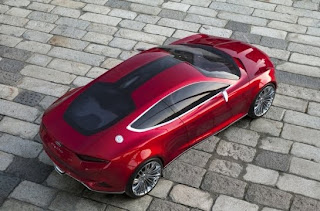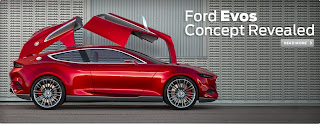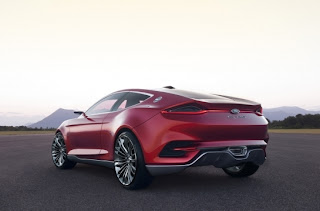
You’ve heard us use the term “global design” before on TheFordStory.com; it basically refers to the foundation of new Ford products that can be used worldwide. To simplify that even further, it’s like automotive DNA. And, it’s also part of the One Ford product plan.
Click Here to watch a video.
The Ford Evos Concept, which will officially debut at the 64th Frankfurt International Motor Show, held September 15-25, 2011, might give you the biggest hint of all regarding the DNA of the next generation of Ford cars and crossovers.

“The Ford Evos Concept is a strong statement of intent from the global design team, and highlights the compelling vision we have for our future products. We believe that the new generation of buyers around the world has higher expectations for a more premium design language in all products,” explained J Mays, Group Vice President, Design and Chief Creative Officer.
Click Here for a Ford Evos Concept - technology demonstration
Take special note of the interior and exterior of the four-seater. There’s a fastback roof profile, which screams aerodynamic efficiency. There’s a sporty appearance. Its architecture is muscular. And about the face: The familiar Ford inverted trapezoid grille has been moved upward, which you might have already noticed on the new Focus Electric and Focus ST.

But it’s not only the design that’s important here. “The Ford Evos Concept unites three key elements which are at the core of our One Ford global product strategy: outstanding design, smart technologies and fuel economy leadership,” said Derrick Kuzak, Group Vice President of Global Product Development.
Driver interaction and awareness are key features. You’ve heard references to “the cloud”? It’s alive and well here. The technology on the Ford Evos Concept reflects a new generation of driver interaction and awareness currently under development in the Ford Research and Innovation laboratories. Seamless connectivity between the vehicle and the driver’s “personal cloud” of information is at the heart of its capabilities. Ford researchers are focusing efforts on delivering four key customer benefits: personalization, enhancement of the driving experience, looking after the driver’s well-being and smart electrified powertrain optimization.
Using information from the cloud, the vehicle can provide the same connected lifestyle the driver experiences at home or office. The car knows the driver and automatically adapts handling, steering and engine controls to deliver a dynamic driving experience. For example, imagine if it could automatically play the same music or news program that was just streaming at home, or heat or cool the interior to an ideal temperature before you got in, without input from you, since it would predict your departure time based on your calendar. Wirelessly communicating with devices in the home, it could close the garage door and switch off the lights automatically as it pulls away.
Learning driver habits and capabilities, the technology can overlay map and weather data sourced from the cloud to adjust powertrain, steering, suspension and braking systems for comfort and safety.

And Ford researchers have already developed technologies focused on driver wellness, such as the heart-rate monitoring seat and certified allergy-free interiors. With a seamless connection to the cloud, the Ford Evos Concept monitors the physical state and workload of the driver and adjusts the driving experience accordingly. The concept is also equipped with advanced air quality sensors and filtration systems to help allergy sufferers. Location-aware, it can access air-quality data from the cloud and proactively suggest a healthier route to the destination.
In dynamic driving situations, the vehicle may simplify the appearance of the instrument panel to display only necessary gauge information and switch the driver’s connected smartphone to Do Not Disturb mode to help keep the focus on the road.

What about performance? The Ford Evos Concept is a state-of-the-art lithium-ion plug-in hybrid (PHEV) powertrain, providing the same next-generation performance and fuel economy as the Ford C-MAX Energi scheduled for introduction in North America in 2012 and Europe in 2013. Cloud connectivity would provide further opportunities to enhance performance and efficiency by selecting the optimum combination of powertrain modes for any given journey. Ford researchers are working to increase understanding of driver behavior, develop accurate protocols to predict it and enhance the trip by providing the smartest use of fuel or battery for the situation. The cloud-optimized powertrain would automatically “know” when to save energy and switch modes, using information about the vehicle’s predicted travel route, any emission zone restrictions during the journey and current weather conditions.
“We wanted the Ford Evos Concept to give a clear message about where Ford design is heading – shaping vehicles that are fun to drive, have a premium appeal but, above all, are stunningly beautiful,” said J. “The first fruit of this vision will be ready sooner than you might think – you’ll see it in around four months rather than four years. We can’t wait to introduce the first production car to include this new Ford design to our global customers.”
Source: Ford/Youtube






